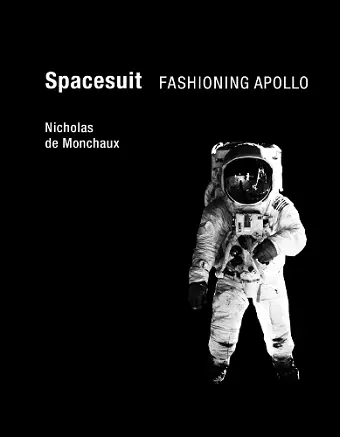Spacesuit
Fashioning Apollo
Format:Paperback
Publisher:MIT Press Ltd
Published:18th Mar '11
Should be back in stock very soon

A layered tour through the interwoven histories of spaceflight and its clothing, rethinking the body's technologies in the cybernetic era. The first sartorial history of spaceflight! -- David Mindell, Director, Program in Science, Technology, and Society, MIT, and author, Digital Apollo: Human and Machine in Spaceflight A veritable fantastic voyage! Not only along the intricate and incredible journey that it turns out links brassiere to stratosphere, but deep inside the ether wherein architecture and fashion form the nebulae of contemporary life. Combining humor and lightness with exacting attention to detail, de Monchaux's book offers a new model of scholarship that revises our view of technology as a hard instrument of science and gently reveals it to be part of the vast flux of cultural production. -- Sylvia Lavin, Director of Critical Studies, Architecture and Urban Design, UCLA Nicholas de Monchaux offers in this remarkable book a far-reaching and broad-based analysis of the spacesuit, interpreting it as far more than a functional garment protecting astronauts: as an artifact at the nexus of society, science, and spacefaring. Far from the internalist histories so common for NASA, de Monchaux ranges from popular culture to technology to advertising to art, in the process illuminating the subtleties of construction and use of this individualized spacesuit. -- Roger D. Launius, Senior Curator, Smithsonian National Air and Space Museum This surely is one of the most deeply researched books on design ever written. De Monchaux follows the history of -- among other things -- fashion, space travel, politics, and architecture to demonstrate an astonishing relationship between what the Apollo astronauts wore and the design of the built environment. -- Ralph Caplan, author of By Design: Why There Are No Locks on the Bathroom Doors in the Hotel Louis XIV and Other Object Lessons, and and 2010 recipient of the Smithsonian's "Design Mind" National Design Award Woven, as befits its topic, with multiple and colored threads borrowed from an astounding variety of fields and domains -- technology, politics, media, and fashion design, to name only a few -- this path-breaking book provides an innovative reading of the space race. Above all, it illuminates the relevance of this race for designers from yesterday and today. -- Antoine Picon, G. Ware Travelstead Professor of the History of Architecture and Technology, Harvard Graduate School of Design
How the twenty-one-layer Apollo spacesuit, made by Playtex, was a triumph of intimacy over engineering.
How the twenty-one-layer Apollo spacesuit, made by Playtex, was a triumph of intimacy over engineering.
When Neil Armstrong and Buzz Aldrin stepped onto the lunar surface in July of 1969, they wore spacesuits made by Playtex: twenty-one layers of fabric, each with a distinct yet interrelated function, custom-sewn for them by seamstresses whose usual work was fashioning bras and girdles. This book is the story of that spacesuit. It is a story of the triumph over the military-industrial complex by the International Latex Corporation, best known by its consumer brand of "Playtex"—a victory of elegant softness over engineered hardness, of adaptation over cybernetics.
Playtex's spacesuit went up against hard armor-like spacesuits designed by military contractors and favored by NASA's engineers. It was only when those attempts failed—when traditional engineering firms could not integrate the body into mission requirements—that Playtex, with its intimate expertise, got the job.
In Spacesuit, Nicholas de Monchaux tells the story of the twenty-one-layer spacesuit in twenty-one chapters addressing twenty-one topics relevant to the suit, the body, and the technology of the twentieth century. He touches, among other things, on eighteenth-century androids, Christian Dior's New Look, Atlas missiles, cybernetics and cyborgs, latex, JFK's carefully cultivated image, the CBS lunar broadcast soundstage, NASA's Mission Control, and the applications of Apollo-style engineering to city planning. The twenty-one-layer spacesuit, de Monchaux argues, offers an object lesson. It tells us about redundancy and interdependence and about the distinctions between natural and man-made complexity; it teaches us to know the virtues of adaptation and to see the future as a set of possibilities rather than a scripted scenario.
The most delightful and memorable new book I read last year was 'Spacesuit,' by Nicholas de Monchaux ... [I]t offers a wonderful David & Goliath story about the triumph of Oldenburg-like soft objects over phallic, rigid ones, and of hard-working seamstresses over hard-nosed engineers.
—The New YorkerSpacesuit pays worthy homage to that often overlooked but essential technology for human space exploration.
—The Space ReviewThe density of ideas and connections is intoxicating. De Monchaux swings masterfully between subjects, teasing out unexpected connections and spotting the seeds of contemporary life that were planted by the space race.
—IconDe Monchaux has an ear for a good story and affection for the historical characters…Spacesuit offers a broad and creative appraisal of that suit's many contexts, encouraging readers to consider technology as design, shaped by the circumstances of its time, unfailingly and elegantly layered and crafted to serve a purpose.
—NatureDe Monchaux's thorough and artful history of the American spacesuit takes readers at a leisurely pace through the past, from the first air travel (via balloon) through fashions of the mid-20th century and manned missions into outer space.
—Publishers WeeklySpacesuit bursts with dinner-party fodder: Did you know that the U.S. government's documentation of the Bikini Atoll nuclear tests created a worldwide film shortage? Or that the Apollo mission's computer-backup system was crafted into a binary pattern that was then physically woven into ropes? And that only seamstresses could be called upon to do this work properly?
—Los Angeles Review of Books- Winner of <PrizeName>Winner, 2011 Eugene M. Emme Astronautical Literature Award, given by the American Astronautical Society.</PrizeName> 2011
ISBN: 9780262015202
Dimensions: 229mm x 178mm x 23mm
Weight: 1157g
380 pages